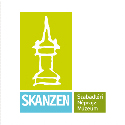Óbuda Museum
Óbuda Museum: LEAVING A MARK. THE DECORATIVE MOTIF AS A MOBILE AND MULTIFUNCTIONAL HERITAGE
The pilot project was based on the traditional arts and crafts of Ukraine, which should not be interpreted primarily as a handicraft activity, but as a visual thinking exercise that focuses on the contextual, symbolic and even philosophical meanings behind the use of motifs. The patterns are not merely decorative elements, but visual means of expressions of memory, trauma, and community and individual identity.
The target group of the pilot project was displaced persons arriving from Ukraine and currentky living in Budapest, belonging to different age groups. The museum staff organized two-day workshops for three different groups: two student groups from the Julianna Primary School of the Budapest–Fasori Reformed College, and a mixed group with adults and children organized by the Catholic Caritas, the official aid organization of the Hungarian Catholic Church. All together 44 people participated in the project, and oral history recordings were also made with four participants by the museologist of the institution.
The project work consisted of research, design and creative activities, which ended with the opening of an exhibition presenting the works of the participants. After collecting data on traditional Ukrainian decorative art, an objective analysis was carried out, which was transformed by the participants through a personal reinterpretation based on their own experiences. During the design process stories were told, emotions and information were displayed. The programme took place in the museum's Goldberber Textile Collection where the participants were able to get acquainted with the authentic Ukrainian textile patterns, a set of symbols of the Crimean Tatars known as Örnek, which is included in the list of intangible cultural heritage of Ukraine.
The methodological foundations of the programme are experiential and cooperative learning, narrative and project pedagogy. The participants did not learn the techniques of pattern making in theory, but they tried it in practice. This process helped to achieve deeper understanding, longer-term knowledge retention, and the processing of experiences. During the Örnek pattern making, the participants told stories in visual language, which is a particularly effective tool for identity formation and self-expression. The two days functioned as a complex project, built on problem-solving and creative tasks. The participants own decisions reflected in pattern selection and creating meaning. They also created a community print project using each participants’ own motif in the same textile surface.
One odd features of the project is that its location was a museum site created from the former factory building of the Jewish Goldberger family, who immigrated to Óbuda from Bohemia and Moravia, with a multi–ethnic, inclusive attitude. Another characteristic is that the project is also excellently suited to processing the visual culture of other nationalities. It can be adapted to any cultural environment where traditional decorative elements and community memory play an important role. The Óbuda Museum plans to continue the programme with Croatian nationalities living in Budapest, tailored to the motif system and pattern making traditions of the specific community.
Adaptation:
All elements of the project can be adapted in organisations where any branch of decorative arts is present. It may also be recommended for institutions that actively deal with issues of cultural identity, traditions, memory politics or migration. It is especially suitable for museums that deal with the deep exploration of visual language, contemporary cultural interpretations or the social role of design.
Feedback of the participants:
The project participants gave positive feedback to the satisfaction questionnaire regarding whether the project had increased their knowledge about Ukrainian intangible cultural heritage elements:
“I managed to learn about traditional embroidery.”
“I learned how to make seals and the beauties of the textile industry.”
“I learned a lot about national motifs.”





